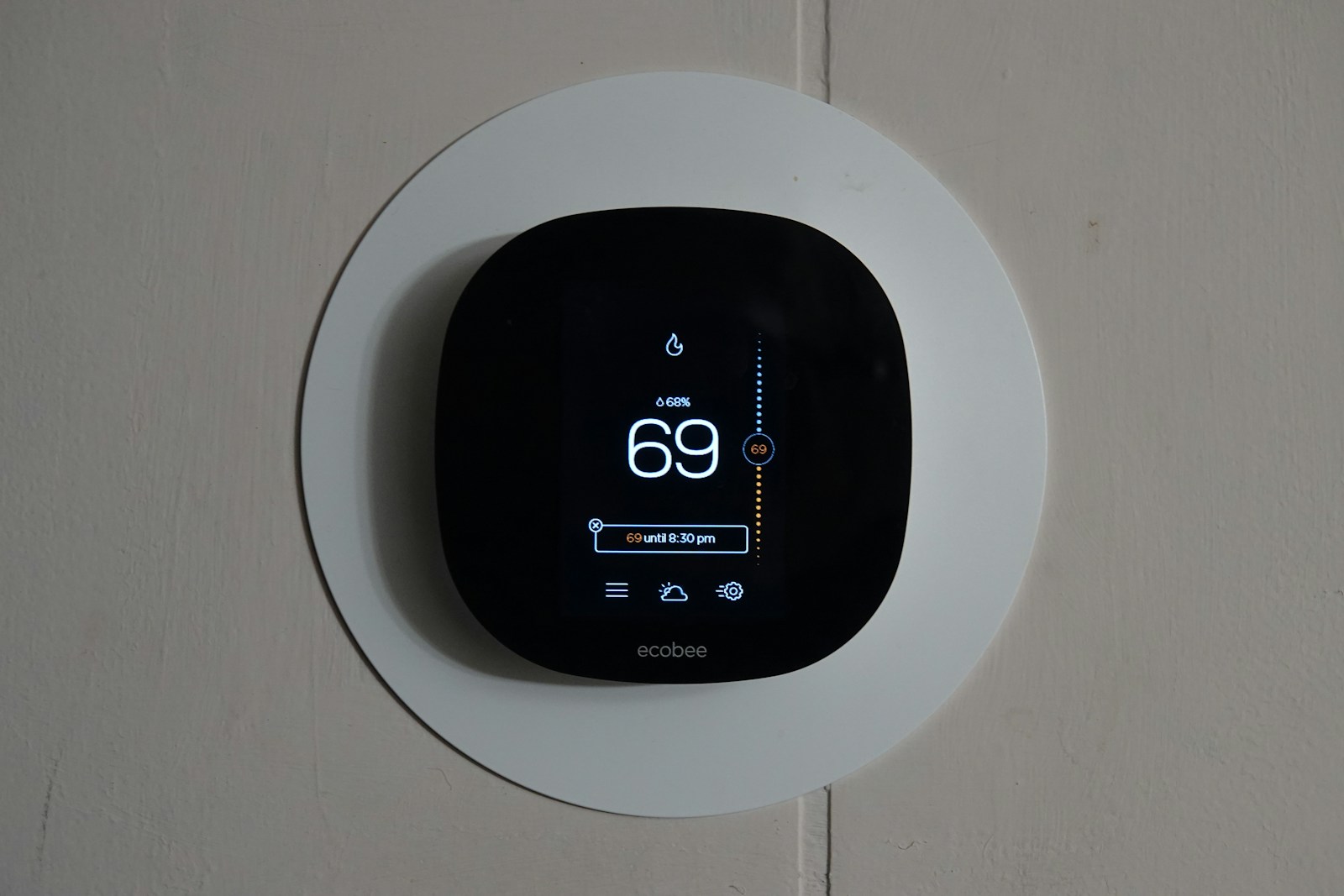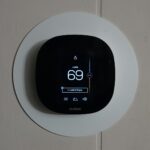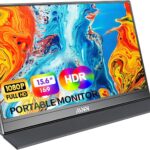Smart home technology has transformed how we live, making our homes more convenient, efficient, and secure. With countless devices available in 2025, finding the right products for your needs can feel overwhelming. The best smart home products seamlessly integrate into daily routines while providing genuine benefits like energy savings, enhanced security, or improved comfort.
These devices range from essential security cameras and smart thermostats to convenient voice assistants and automated lighting systems. Many homeowners begin with simple products before expanding their smart home ecosystem over time. As technology continues to advance, today’s smart home devices offer better performance, easier setup, and more features than ever before.
1: Google Nest Thermostat
The Google Nest Thermostat stands out as a popular choice for homeowners looking to make their heating and cooling systems smarter. This device learns your habits and preferences to create an automatic schedule that keeps your home comfortable.
The Nest Thermostat works with your smartphone, allowing you to control your home’s temperature from anywhere. This feature is particularly useful when you’re coming home early or staying out later than planned.
Energy efficiency is a key benefit of the Nest Thermostat. It suggests energy-saving adjustments that can help reduce utility bills without sacrificing comfort. These recommendations are based on your usage patterns and local weather conditions.
Installation is relatively straightforward for most users. The Nest app guides you through the setup process, making it accessible even for those who aren’t particularly tech-savvy.
The thermostat’s design is sleek and modern. Its simple interface allows users to make quick adjustments with a turn of the dial or a tap on the screen. The display shows temperature clearly and adapts its brightness to the surrounding light.
Different Nest Thermostat models are available to match various needs and budgets. The standard Nest Thermostat offers essential smart features, while premium versions include additional capabilities.
Some HVAC professionals have expressed concerns about compatibility with certain systems. It’s worth checking if your heating and cooling setup works well with Nest before purchasing.
Compared to competitors like Ecobee, the Nest Thermostat focuses more on simplicity and learning capabilities. While Ecobee devices offer extras like voice assistant integration and air quality monitoring, Nest prioritizes its core temperature control functions.
The Nest Thermostat connects with other Google smart home products. This integration allows for convenient voice control through Google Assistant and automated routines that work with other connected devices.
2: Amazon Echo Dot (5th Gen)
The Amazon Echo Dot (5th Gen) stands out as the best Alexa speaker for beginners. This compact smart speaker packs all the standard Alexa features into an affordable package, making it a great entry point into smart home technology.
Sound quality has improved significantly over previous generations. Despite its small size, the Echo Dot delivers clear audio that works well for casual music listening, podcasts, and voice responses from Alexa.
The device maintains its signature spherical design with a fabric cover. Its small footprint allows it to fit nearly anywhere in your home without being obtrusive.
Setting up the Echo Dot is straightforward. Users simply connect it to their home Wi-Fi network through the Alexa app and can begin using voice commands immediately. The device responds quickly to the “Alexa” wake word.
Voice recognition technology in the 5th Gen model has been refined. It can hear commands from across a room even when music is playing, which was a challenge for earlier models.
The Echo Dot serves as an excellent hub for controlling other smart home devices. Users can connect compatible lights, plugs, thermostats, and more to create a comprehensive smart home system controlled by voice.
Privacy features include a physical button to disable the microphone when desired. Amazon has also improved its privacy controls within the Alexa app, giving users more control over their data.
Battery life is not a concern as the Echo Dot requires constant power. It comes with a power adapter that plugs into a standard wall outlet.
The price point makes this device particularly attractive. As one of the more affordable smart speakers on the market, it offers excellent value for the features provided.
For those who want to expand their smart home setup later, the Echo Dot integrates seamlessly with other Amazon Echo products. This allows for easy scaling of the system throughout the home.
Amazon regularly updates the Echo Dot’s software, adding new features and capabilities over time. This helps keep the device relevant even as smart home technology advances.
3: Philips Hue White and Color Ambiance Bulbs
Philips Hue White and Color Ambiance Bulbs stand out as one of the most versatile smart lighting options available today. These LED bulbs offer users complete control over both brightness and color, with millions of color options to choose from. They allow homeowners to transform their living spaces with just a few taps on their smartphone.
The Philips Hue ecosystem operates on Zigbee technology, making it a reliable and scalable option for smart home enthusiasts. Most setups begin with a starter kit that includes several bulbs and the necessary Hue Hub that connects them to your home network.
These smart bulbs integrate seamlessly with major voice assistants including Amazon Alexa, Google Assistant, and Apple HomeKit. This compatibility ensures users can control their lighting through voice commands or automated routines.
One of the key advantages of the Hue system is its expandability. Homeowners can start with a basic kit and gradually add more bulbs, light strips, or even outdoor lighting options as their needs grow.
The Philips Hue app offers intuitive control over individual bulbs or grouped lighting zones. Users can create and save custom scenes for different activities or times of day. The app also supports scheduling features that can automatically adjust lighting based on time or other triggers.
Color reproduction in these bulbs is excellent, with vibrant hues and subtle shades all rendered accurately. The white light settings range from warm, cozy tones to crisp, energizing daylight, making them suitable for any room or mood.
Battery life is not a concern as these bulbs connect directly to standard light fixtures. Their energy efficiency significantly outperforms traditional incandescent bulbs while offering far more functionality.
While Philips Hue products tend to be more expensive than some competitors, their reliability and extensive ecosystem justify the investment for many users. The bulbs are rated for approximately 25,000 hours of use, ensuring years of service under normal conditions.
Recent updates to the Hue system have improved response times and added new features like dynamic lighting scenes that slowly transition between colors. These enhancements keep the system competitive in the rapidly evolving smart lighting market.
4: August Smart Lock Pro
The August Smart Lock Pro is a leading smart home device that brings security and convenience to your front door. This Wi-Fi-enabled lock allows homeowners to control access to their homes remotely using a smartphone app. It’s designed to work with existing deadbolts, making installation straightforward without replacing your current lock.
One of the standout features of the August Smart Lock Pro is its compatibility with major smart home systems. It works seamlessly with voice assistants like Alexa and Google Assistant, allowing for hands-free control. The lock also integrates with other smart home platforms such as Samsung SmartThings and Philips Hue.
Installation requires no additional hardware for Wi-Fi connectivity. This means users get full remote access functionality without extra components cluttering their entryway. The lock attaches to the inside of your door, allowing you to keep and use your original keys if needed.
The August Home app provides comprehensive control options. Users can lock or unlock their door from anywhere, check lock status, and even share virtual keys with family members or guests. The app also tracks who comes and goes with a detailed activity log.
Auto-unlock is another helpful feature that recognizes when you’re approaching home. The door will automatically unlock as you arrive, which is particularly useful when your hands are full of groceries or other items.
For added security, the August Smart Lock Pro offers DoorSense technology. This feature tells you if your door is completely closed and locked, providing peace of mind when you’re away from home.
The lock is powered by batteries that typically last several months. The app sends notifications when battery power runs low, preventing unexpected lockouts. If batteries do die, the physical key still works as a backup.
When paired with the August Connect Wi-Fi Bridge, the lock gains additional capabilities. This hub extends the Bluetooth range of the lock and enables integration with more smart home systems and remote access features.
Smart Lock Pro offers customizable security settings to fit different lifestyles. Users can set automatic locking after a specified time period or create temporary access codes for service providers or short-term guests.
The sleek, circular design fits modern home aesthetics without drawing too much attention to itself. Its understated appearance conceals its sophisticated technology while complementing various door styles and colors.
5: Ring Video Doorbell 4
The Ring Video Doorbell 4 represents an evolution in smart home security, offering homeowners a reliable way to monitor their front door. Released as an upgrade to previous models, this doorbell camera maintains Ring’s reputation for quality while adding several new features.
Priced between $200 and $220, the Ring Video Doorbell 4 delivers 1080p HD video quality. This resolution ensures clear footage of visitors and activity outside your home, even during nighttime hours thanks to its night vision capabilities.
One notable improvement in this model is the color pre-roll feature. This function captures four seconds of video before motion is detected, giving homeowners more context about events happening at their door. This can be particularly useful for package deliveries or security concerns.
The device offers flexible installation options. Users can choose between battery power or wired installation depending on their home setup and preferences. The battery option provides convenience while the wired connection ensures you never need to worry about charging.
Two-way talk functionality allows homeowners to communicate with visitors directly through the doorbell. Whether greeting guests or giving instructions to delivery personnel, this feature enhances the doorbell’s utility beyond simple monitoring.
Ring’s quick replies feature provides pre-recorded messages for times when homeowners cannot answer the door personally. This automated response system helps maintain communication even when residents are busy or away from home.
The Ring Video Doorbell 4 integrates seamlessly with other Ring products and compatible smart home systems. This connectivity allows for a more comprehensive home security setup that can include cameras, alarms, and smart lighting.
Users can monitor and control their doorbell through Ring’s mobile app. The app provides notifications when motion is detected or when someone rings the doorbell, allowing homeowners to stay informed about activity at their front door from anywhere.
6: TP-Link Kasa Smart Plug
The TP-Link Kasa Smart Plug offers an excellent way to add intelligence to ordinary home appliances. These devices plug into standard wall outlets and allow users to control connected devices remotely. The Kasa Smart Wi-Fi Plug Slim (EP25) stands out as a top choice for indoor use according to recent reviews.
Users appreciate the Kasa Smart Plug for its reliability and straightforward setup process. The EP10 model has gained a reputation for stability and ease of integration with the Kasa app. For those who don’t need energy monitoring features, the EP10 provides the essential functions at a reasonable price point.
The companion Kasa app is user-friendly and intuitive. It gives homeowners control over their smart devices from anywhere with an internet connection. This remote accessibility makes it possible to manage appliances even when away from home.
One of the main benefits of these smart plugs is automation. Users can create schedules for devices to turn on and off automatically. This feature helps improve energy efficiency and can reduce electricity bills over time.
The smart plugs integrate well with voice assistants. This means users can control their appliances through simple voice commands to devices like Amazon Alexa or Google Home. The hands-free operation adds another layer of convenience.
TP-Link designs their Kasa Smart Plugs with a slim profile. This prevents them from blocking adjacent outlets, allowing for more efficient use of wall space. The compact design works well in tight spaces where bulkier smart plugs might cause problems.
For those building a comprehensive smart home system, these plugs work alongside other Kasa products. The unified app experience simplifies management of multiple smart devices. Users don’t need to juggle different apps for each smart home component.
The Kasa Smart Plugs don’t require a separate hub to operate. They connect directly to home Wi-Fi networks, making them an accessible entry point for smart home beginners. This plug-and-play approach reduces the complexity of setting up a connected home.
7: Samsung SmartThings Hub
The Samsung SmartThings Hub serves as a central command center for smart home devices. It connects various gadgets and allows them to work together seamlessly. This hub has been a popular choice for many smart home enthusiasts.
One key feature of the SmartThings Hub is its compatibility with both Zigbee and Z-Wave devices. This dual support means it can connect with a wide range of smart products from different manufacturers. Users don’t need to worry about buying devices from only one brand.
The hub allows for local processing of some automations. This means certain commands will work even if the internet goes down. However, many functions still rely on cloud connectivity to operate properly.
Samsung has released several versions of the SmartThings Hub over the years. Each new generation has brought improvements in speed, reliability, and features. The newer models are more compact and blend into home decor better than earlier versions.
Setting up the SmartThings Hub is relatively straightforward. Users connect it to their home network, download the SmartThings app, and then begin adding devices. The app walks through the process step by step.
The SmartThings app offers an intuitive interface for controlling devices. Users can create rooms, scenes, and automated routines. They can also set devices to trigger based on time, location, or other device actions.
Samsung has expanded the SmartThings ecosystem to include options like SmartThings Wifi and Connect Home. These devices combine mesh WiFi networking with smart home hub capabilities. This integration reduces the number of devices needed in the home.
The SmartThings platform works with many popular smart home brands. It supports products from companies like Philips Hue, Ring, Arlo, and Ecobee. This makes it a versatile choice for people who already own smart devices.
For those concerned about privacy, it’s worth noting that many SmartThings functions rely on cloud processing. This means data from devices often travels to Samsung’s servers before commands are executed. Local processing options are limited compared to some competitors like Hubitat Elevation.
8: Eufy Security SoloCam E40
The Eufy Security SoloCam E40 stands out as one of the most affordable 2K battery-powered home security cameras available today. This wireless outdoor camera delivers detailed and clear footage, making it an excellent choice for homeowners concerned about security.
With its 2K resolution, the SoloCam E40 captures crisp video that allows users to see important details when reviewing footage. The camera’s quality is particularly impressive considering its price point in the security camera market.
One notable feature is the camera’s built-in PIR (Passive Infrared) sensor. According to user reviews, the SoloCam series has better PIR sensors compared to other models, which helps reduce false alerts while ensuring actual movement is detected.
The SoloCam E40 comes equipped with a loud 90dB alarm that can be triggered through the eufy Security app. This feature serves as an effective deterrent, allowing homeowners to scare off potential intruders remotely.
Integration with smart home systems adds to the E40’s appeal. The device is compatible with popular voice assistants like Amazon Alexa and Google Assistant, allowing for convenient voice control and integration with existing smart home setups.
Battery life is another strength of the SoloCam E40. Being completely wireless, the camera offers flexibility in placement without requiring nearby power outlets. This makes installation simpler for the average homeowner.
The eufy Security app provides a user-friendly interface for monitoring and controlling the camera. Users can view live footage, access recordings, and adjust settings directly from their smartphones regardless of their location.
For those concerned about privacy, the SoloCam E40 stores footage locally rather than requiring a cloud subscription. This approach enhances security while eliminating monthly fees that often accompany other security cameras.
9: Sonos Beam Soundbar
The Sonos Beam is a versatile smart soundbar that transforms any living space into an immersive home theater. This compact device packs impressive audio quality into a sleek design that fits perfectly beneath most TVs.
Available in both first and second-generation models, the Beam (Gen 2) offers enhanced features including Dolby Atmos support. This technology creates a more three-dimensional sound experience that makes movies and shows more engaging.
Voice control is a standout feature of the Beam. With Amazon Alexa and Google Assistant built-in, users can adjust volume, skip tracks, or get news updates without lifting a finger.
The soundbar delivers balanced audio at any volume level. This means late-night viewing won’t wake the household, while the system still maintains clarity and detail even at lower settings.
For smart home enthusiasts, the Beam integrates seamlessly with other devices. It works well with AirPlay, making it easy for Apple users to stream content directly from their devices.
Setup is remarkably simple compared to other audio systems. Most users find the process intuitive, with the soundbar connecting easily to TVs via HDMI.
The second-generation Beam earned positive reviews for its improved sound quality. While the voice assistant functionality occasionally has minor glitches, the overall performance is reliable.
For those wanting to expand their audio setup, the Beam works as part of a larger Sonos ecosystem. Users can add additional speakers over time to create a full surround sound experience.
The clean design of the Beam complements modern home décor. Available in black or white, it’s an attractive addition to any entertainment setup without being visually distracting.
While not the cheapest soundbar on the market, the Beam’s combination of smart features and quality sound makes it a worthy investment for anyone looking to upgrade their TV audio experience.
10: Arlo Pro 4 Spotlight Camera
The Arlo Pro 4 Spotlight Camera stands out as a premium security solution for smart homes. This 2K HDR camera delivers exceptional video quality, allowing homeowners to monitor their property with crystal-clear footage.
One of the most convenient features of the Pro 4 is its ability to connect directly to Wi-Fi without requiring a SmartHub. This simplifies the setup process and makes it more accessible for users who want to expand their security system gradually.
The Arlo Pro 4 integrates seamlessly with various smart home ecosystems. Users can receive alerts and manage their security through popular platforms like Amazon Alexa, Google Home, Apple HomeKit, and Samsung SmartThings.
The spotlight feature adds an extra layer of security by illuminating potential threats and capturing color footage at night. This functionality helps deter unwanted visitors while providing better visibility in recordings.
Some users have reported concerns about live feed delays. According to online discussions, there might be a delay in the live feed, which could be a consideration for those who need immediate real-time monitoring.
The camera’s design is sleek and modern, blending well with home exteriors. Arlo has focused on creating aesthetically pleasing products that don’t detract from a home’s appearance while providing robust security features.
Battery life is another strength of the Arlo Pro 4, allowing for extended use without frequent recharging. The wireless design offers flexibility in placement around the property without worrying about proximity to power outlets.
The Arlo app provides comprehensive control over the camera’s features and settings. Users can customize motion detection zones, adjust sensitivity, and receive customized notifications based on their preferences.
Understanding Smart Home Technology
Smart home technology has transformed how we interact with our living spaces. The devices have become more sophisticated and interconnected, offering convenience, energy efficiency, and enhanced security for homeowners.
The Evolution of Smart Home Devices
Smart home technology began with simple remote-controlled devices in the 1990s. These early innovations laid the groundwork for today’s advanced systems that feature voice control, AI integration, and learning capabilities.
By 2025, smart devices have become more intuitive and responsive. Modern systems can anticipate user needs based on patterns and preferences. The market has expanded from basic smart speakers to comprehensive ecosystems that include lighting, thermostats, security cameras, and appliances.
Today’s devices focus on seamless integration and user-friendly interfaces. Companies like Philips Hue, Apple, and Blink have revolutionized everyday items like lightbulbs, speakers, and security systems with wireless connectivity and smartphone control.
The technology has also become more accessible and affordable, bringing smart home capabilities to a wider audience.
Integration with IoT
The Internet of Things (IoT) forms the backbone of modern smart home systems. This network allows devices to communicate with each other and with users through internet connectivity.
Smart home hubs serve as central command centers, enabling different brands and types of devices to work together. Popular platforms include:
- Amazon Alexa
- Google Home
- Apple HomeKit
- Samsung SmartThings
These systems allow users to create automated routines and scenarios. For example, a “goodnight” command might lock doors, adjust thermostats, and turn off lights simultaneously.
Security remains a critical consideration in IoT integration. Manufacturers now implement stronger encryption and regular security updates to protect user data and privacy.
The future of smart home technology lies in even deeper integration, with AI playing a larger role in anticipating needs and managing home systems with minimal user input.
Privacy and Security Considerations
As smart homes become more common, protecting your personal data and securing your devices is crucial. Smart devices collect a lot of information about your daily habits, making privacy and security essential aspects to consider when building your connected home.
Data Privacy in Smart Homes
Smart home devices constantly gather data about your activities and preferences. This includes when you’re home, what rooms you use most, and even your sleep patterns. Many devices use end-to-end encryption to protect this sensitive information during transmission.
However, privacy concerns remain significant. Smart thermostats track when you’re home, cameras record activity both inside and outside your house, and voice assistants listen for commands. All this data gets stored and sometimes shared with third parties.
Before purchasing any smart device, review the manufacturer’s privacy policy. Look for companies that clearly state what data they collect and how they use it. Consider devices that offer local processing rather than sending all data to the cloud.
Some manufacturers provide options to delete your data periodically or limit what information is collected. These settings can significantly improve your privacy while still allowing you to enjoy smart home benefits.
Best Practices for Securing Smart Devices
Creating a secure smart home starts with proper device selection. Purchase products from reputable companies that offer regular security updates and long-term support. Avoid cheaper alternatives that might stop receiving updates quickly.
Set up a separate Wi-Fi network specifically for your smart devices. This keeps them isolated from your main network where you store sensitive information. Many modern routers offer guest network features that work perfectly for this purpose.
Always change default passwords on all devices and use strong, unique passwords for each one. Enable two-factor authentication wherever available for an extra layer of security.
Keep an inventory of all connected devices in your home. This helps you track which devices need updates and ensures you don’t forget about any potential security risks. Update firmware regularly as manufacturers often patch security vulnerabilities.
Disable features you don’t use, especially remote access functions if unnecessary. The fewer connections to the outside world, the fewer potential entry points for hackers.
Frequently Asked Questions
Smart home technology can be confusing for many consumers. These common questions address key concerns about compatibility, features, and recommendations for those looking to build or expand their smart home setup.
What are the top-rated smart home devices currently on the market?
The Google Nest Thermostat consistently ranks among the highest-rated smart home devices available today. It offers energy-saving features and learns user preferences over time.
The Amazon Echo Dot (5th Gen) has received excellent reviews for its improved sound quality and compact design. It serves as both a smart speaker and a hub for controlling other devices.
Philips Hue White and Color Ambiance Bulbs remain industry leaders in smart lighting, with users praising their reliability and extensive color options.
Which smart home devices offer the best compatibility with multiple platforms?
Philips Hue lighting products work with nearly all major platforms including Amazon Alexa, Google Assistant, Apple HomeKit, and Samsung SmartThings. This wide compatibility makes them versatile additions to any smart home.
The Ring Video Doorbell 4 integrates well with most ecosystems, though it works most seamlessly with Amazon Alexa devices. It offers compatibility beyond just Amazon’s ecosystem.
Smart plugs from brands like TP-Link and Wemo typically support multiple voice assistants and platforms, making them excellent starter devices.
What features should one consider when choosing a smart home system?
Compatibility with existing devices should be a primary consideration. Purchasing products within the same ecosystem often ensures smoother integration.
Security features such as end-to-end encryption and two-factor authentication help protect sensitive home data and access.
Power backup options keep critical systems running during outages. This is especially important for security devices and smart locks.
User-friendly interfaces make daily interaction with smart devices more pleasant. Look for apps with intuitive controls and responsive design.
How do smart home hubs differ from each other in terms of functionality?
Amazon Echo devices focus on voice control through Alexa and offer strong entertainment features like music streaming and video calling on screen-equipped models.
Google Nest Hub emphasizes visual information display and seamless integration with Google services like Calendar, Maps, and YouTube.
Samsung SmartThings hubs provide extensive third-party device support and advanced automation capabilities for tech-savvy users.
Apple HomePod focuses on premium audio quality while serving as a HomeKit hub with privacy-focused features.
What are the essential smart home gadgets recommended for beginners?
Smart speakers like the Amazon Echo Dot serve as excellent entry points into home automation. They provide voice control capabilities and often act as hubs for other devices.
Smart plugs offer an affordable way to make regular appliances “smart” without replacing them entirely. They’re simple to set up and require minimal technical knowledge.
Video doorbells like the Ring Video Doorbell 4 provide immediate security benefits and are straightforward to install and use.
Smart bulbs offer both practical lighting control and fun customization options without requiring electrical work in most cases.
Which smart home automation products are consumers most satisfied with based on recent reviews?
The August Smart Lock Pro receives consistently high satisfaction ratings for its reliable performance. It also has thoughtful features like auto-unlock when residents approach home.
Philips Hue lighting systems generate positive feedback for their stability, color accuracy, and extensive integration options with third-party apps.
Smart thermostats, particularly the Google Nest, earn praise for their energy savings. They also have learning capabilities that adjust to household routines.
Amazon Echo devices maintain strong consumer satisfaction due to Alexa’s expanding capabilities. They also have a growing ecosystem of compatible products.







